Migration has begun ……
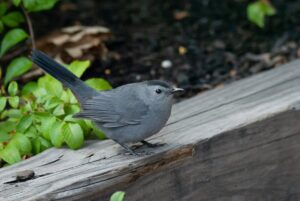
In an earlier blog, I told you that our Rose-breasted Grosbeaks, Gray Catbirds, and Brown Thrashers are gone – they have begun their migration. We now have Gray Catbirds again – here in our yard. One was ‘meowing’ at me yesterday from a thick tangle of vines near the shore of our small lake. But these catbirds are not the ones who lived here all spring and summer and ate so much of the grape jelly in the oriole feeder – which I am sure you all saw on the bird bath live-stream. These catbirds are different. They are in a different part of our yard and do not come near that feeder. So these catbirds left their summer home somewhere north of us – maybe even in Canada – are resting here for a few days, eating the last of the berries on our blueberry and elderberry bushes, and then will move on to our southern states or even as far as Central America or the islands of the Caribbean.
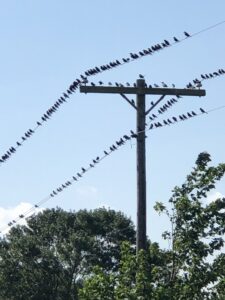
I also shared with you that the Brown-headed Cowbirds started to flock together as early as mid-July – all in preparation for either migrating to our southern states or staying here – they do both. And wherever you are, if you start watching your overhead utility wires, as the weeks go by, you will see more and more of these cowbirds – plus all the other blackbirds such as Red-winged Blackbirds and grackles – gather and roost close together. You will also start to see massive flocks of European Starlings which can also include blackbirds and even the occasional robin and House Sparrow. Swallows are also beginning to flock together to begin their migrations.
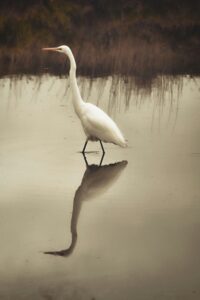
Here at the large lake close to us, I have already shared with you a video of Ring-billed Gulls and Double-crested Cormorants that are coming together to begin migration. And over the last few days, we have been observing Great Egrets. We do have Great Egrets here in our part of central Illinois all summer, but they are more of an ‘Uncommon’ to ‘Rare’ sighting. They might be found at our smaller lakes and ponds and in wetlands, but not always. And if they are there, it will only be a few. We sometimes have them here on our small lake, but we only saw 1 this year and it was not here every day – just off and on. But now on the large lake a few miles from our house, these egrets are gathering. Yesterday, we saw about a dozen – all standing in the shallower waters and foraging for fish and other tasty things living in the water. They were all together in one area of the lake. Another sign that fall is on its way. Great Egrets winter in our southern states. They are residents in Central and South America and on the islands of the Caribbean and it is possible that some migrate that far, but most of the ones who reside here in the Midwest for spring and summer only go as far as our southern states where they are ‘Common’ in wetlands and around water all winter.
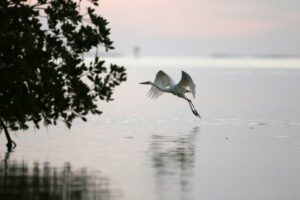
From now until probably the end of October, there will be less activity on both live-stream cams. We do still have 2 Ruby-throated Hummingbirds fighting over the 4 ports in their feeder which you can see on the bird bath cam live-stream. As the weeks go on, there could be others as they migrate through here on their way south. The House Finch families are starting to disperse and we do not have as many as we did two weeks ago – however, House Finches will be here with us all winter and will use the feeders. The Blue Jays remain and we have two pairs of Northern Cardinals that are at the feeders every day. And the White-breasted Nuthatches are starting to use the feeder more often. The Downy and Red-bellied Woodpeckers will remain as will the two Hairy Woodpeckers. The pair of Canada Geese are underneath the feeders just about every day – as are the Mallards. What you will start seeing now are more of our all year round resident birds. They will come to the feeder off and on, but there will be times when there there are no birds on the live-stream and this is part of their normal cycle. Most songbirds molt in August and September and when they do, they are much more quiet. The singing stops, and they spend much time resting and preening. They do still come to the feeders, but not as often. It truly is a quiet time and my guess is that it is a much welcome period after all the energy spent nesting, raising young, and defending territories, nests, mates, and families.
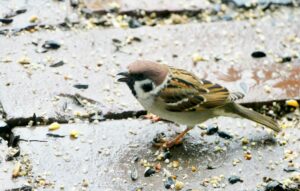
By mid-October and certainly November, start looking for Juncos (in central Illinois, we have the most common subspecies of Junco – Dark-eyed Juncos). You will see them most often on the ground under the feeders. We also have White-throated Sparrows, White Crowned Sparrows, and American Tree Sparrows from time to time. Our Eurasian Tree Sparrows have completely disappeared which has surprised both Cleon and me. We had a flock of about 20 or so with us for the past five years and most especially all through the falls and winters. In fact, as this flock grew, the flock of House Sparrows dwindled until we had none. If you watch both live-streams, you will see House Sparrows have returned – we have about 6 right now. So it will be interesting to see if the Eurasian Tree Sparrows return and if this once again affects the number of House Sparrows. Or will they not return and our House Sparrow population will continue to grow? And where did the Eurasian Tree Sparrows go? I will probably never know the answer to that last question. Eurasian Tree Sparrows have very limited ranges here in the U.S. The ones we have here were originally brought to the St.Louis, MO, area in the late 1800’s and set free. I would guess that most of you are unfamiliar with this bird and their similarity to House Sparrows. If you want to read more about both birds, go to this website’s menu and click on Everything Bird!, then click on Eurasian Tree Sparrows and House Sparrows – Similarities and Differences.
Also in the Everything Bird! section of this website, I have posted an article on pishing – an interesting technique to help you when you are hear birds, but they are hidden from your view. I also posted several new videos this month – the latest one yesterday afternoon. Hope you enjoy them!
Even though birds are much more quiet right now than they have been since the end of last winter, it is a good time to go birding. So many are forming flocks for migration. And if you live along the major flyways, migration is a wonderful time to see all sorts of species you will never see outside migration. Regardless of where you live, birds can migrate through and be found in your neighborhood or favorite park. So sling those binoculars around your neck and take a walk. See what is out there!
And if you would like to let me know what you are seeing and hearing, email me at lindahendricksspence@birdingbeyondthefieldguide.com. I would love to hear about what you are observing. There is nothing I like better than to talk birds!

